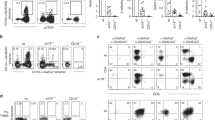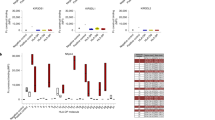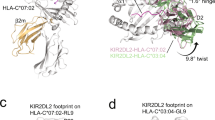Abstract
The Ly49 receptor family plays an important role in the regulation of murine natural killer (NK) cell effector function. They recognize cell surface-expressed class I MHC (MHC-I) and are functionally equivalent to the killer Ig-related receptors (KIRs) in human NK cells. Ly49s exist in activating and inhibitory forms with highly homologous extracellular domains, displaying greater variability in the stalk regions. Inhibitory Ly49s can recognize self-MHC-I and therefore mediate tolerance to self. The role of activating Ly49 receptors is less clear. Some activating Ly49 receptors have been shown to recognize MHC-I molecules. The binding affinity of activating Ly49 receptors with MHC-I is currently unknown, and we sought to examine the affinities of two highly related receptors, an activating and an inhibitory Ly49 receptor, for their shared MHC-I ligands. The ectodomain of inhibitory Ly49G of the BALB/c mouse strain is highly similar to the Ly49W activating receptor in the nonobese diabetic (NOD) mouse. Recombinant soluble Ly49G and W were expressed, refolded, and analyzed for binding affinity with MHC-I by surface plasmon resonance. We found that Ly49G and Ly49W bound with similar affinity to the same MHC-I molecules. These results are a first determination of an activating Ly49 receptor affinity for MHC-I and show that, unlike prior results obtained with activating and inhibitory KIR receptors, functional homologues to Ly49 receptors, activating and inhibitory Ly49, can recognize common MHC-I ligands, with similar affinities.




Similar content being viewed by others
Abbreviations
- CTLD:
-
C-type lectin-like domain
- FACS:
-
Fluorescence-activated cell sorting
- FITC:
-
Fluorescein isothiocyanate
- IgG:
-
Immunoglobulin G
- IPTG:
-
Isopropyl-1-thio-β-d-galactopyranoside
- ITAM:
-
Immunomodulatory tyrosine-based activating motif
- ITIM:
-
Immunomodulatory tyrosine-based inhibitory motif
- KIR:
-
Killer cell immunoglobulin-like receptor
- MCMV:
-
Murine cytomegalovirus
- MHC:
-
Major histocompatibility complex
- MHC-I:
-
MHC class I
- NK:
-
Natural killer
- PE:
-
Phycoerythrin
- SPR:
-
Surface plasmon resonance
- β2m:
-
β2-Microglobulin
References
Abi-Rached L, Parham P (2005) Natural selection drives recurrent formation of activating killer cell immunoglobulin-like receptor and Ly49 from inhibitory homologues. J Exp Med 201(8):1319–1332
Adams EJ, Juo ZS, Venook RT, Boulanger MJ, Arase H, Lanier LL, Garcia KC (2007) Structural elucidation of the m157 mouse cytomegalovirus ligand for Ly49 natural killer cell receptors. Proc Natl Acad Sci U S A 104(24):10128–10133
Anderson SK, Dewar K, Goulet ML, Leveque G, Makrigiannis AP (2005) Complete elucidation of a minimal class I MHC natural killer cell receptor haplotype. Genes Immunol 6(6):481–492
Beckett D, Kovaleva E, Schatz PJ (1999) A minimal peptide substrate in biotin holoenzyme synthetase-catalyzed biotinylation. Protein Sci 8(4):921–929
Belanger S, Tai LH, Anderson SK, Makrigiannis AP (2008) Ly49 cluster sequence analysis in a mouse model of diabetes: an expanded repertoire of activating receptors in the NOD genome. Genes Immunol 9(6):509–521
Brauner H, Elemans M, Lemos S, Broberger C, Holmberg D, Flodström-Tullberg M, Kärre K, Höglund P (2010) Distinct phenotype and function of NK cells in the pancreas of nonobese diabetic mice. J Immunol 184(5):2272–2280
Brennan J, Mahon G, Mager DL, Jefferies WA, Takei F (1996) Recognition of class I major histocompatibility complex molecules by Ly-49: specificities and domain interactions. J Exp Med 183(4):1553–1559
Bridgeman JS, Sewell AK, Miles JJ, Price DA, Cole DK (2012) Structural and biophysical determinants of αβ T-cell antigen recognition. Immunology 135(1):9–18
Campbell KS, Hasegawa J (2013) Natural killer cell biology: an update and future directions. J Allergy Clin Immunol 132(3):536–544
Carbone FR, Bevan MJ (1989) Induction of ovalbumin-specific cytotoxic T cells by in vivo peptide immunization. J Exp Med 169(3):603–612
Carlyle JR, Mesci A, Fine JH, Chen P, Belanger S, Tai LH, Makrigiannis AP (2008) Evolution of the Ly49 and Nkrp1 recognition systems. Semin Immunol 20(6):321–330
Carnaud C, Gombert J, Donnars O, Garchon H, Herbelin A (2001) Protection against diabetes and improved NK/NKT cell performance in NOD.NK1.1 mice congenic at the NK complex. J Immunol 166(4):2404–2411
Cheng TP, French AR, Plougastel BF, Pingel JT, Orihuela MM, Buller ML, Yokoyama WM (2008) Ly49h is necessary for genetic resistance to murine cytomegalovirus. Immunogenetics 60(10):565–573
Dam J, Guan R, Natarajan K, Dimasi N, Chlewicki LK, Kranz DM, Schuck P, Margulies DH, Mariuzza RA (2003) Variable MHC class I engagement by Ly49 natural killer cell receptors demonstrated by the crystal structure of Ly49C bound to H-2K(b). Nat Immunol 4(12):1213–1222
Deng L, Cho S, Malchiodi EL, Kerzic MC, Dam J, Mariuzza RA (2008) Molecular architecture of the MHC-binding site of Ly49 natural killer cell receptors. J Biol Chem 283(24):16840–16849
Foley B, De Santis D, Lathbury L, Christiansen F, Witt C (2008) KIR2DS1-mediated activation overrides NKG2A-mediated inhibition in HLA-C C2-negative individuals. Int Immunol 20(4):555–563
Franksson L, Sundbäck J, Achour A, Bernlind J, Glas R, Kärre K (1999) Peptide dependency and selectivity of the NK cell inhibitory receptor Ly-49C. Eur J Immunol 29(9):2748–2758
Frazier WR, Steiner N, Hou L, Dakshanamurthy S, Hurley CK (2013) Allelic variation in KIR2DL3 generates a KIR2DL2-like receptor with increased binding to its HLA-C ligand. J Immunol 190(12):6198–6208
Garboczi DN, Hung DT, Wiley WC (1992) HLA-A2-peptide complexes: refolding and crystallization of molecules expressed in Escherichia coli and complexed with single antigenic peptides. Proc Natl Acad Sci U S A 89(8):3429–3433
Hanke T, Takizawa H, McMahon CW, Busch DH, Pamer EG, Miller JD, Altman JD, Liu Y, Cado D, Lemonnier FA, Bjorkman PJ, Raulet DH (1999) Direct assessment of MHC class I binding by seven Ly49 inhibitory NK cell receptors. Immunity 11(1):67–77
Held W, Kunz B (1998) An allele-specific, stochastic gene expression process controls the expression of multiple Ly49 family genes and generates a diverse, MHC- specific NK cell receptor repertoire. Eur J Immunol 28(8):2407–2416
Kaiser BK, Barahmand-Pour F, Paulsene W, Medley S, Geraghty DE, Strong RK (2005) Interactions between NKG2x immunoreceptors and HLA-E ligands display overlapping affinities and thermodynamics. J Immunol 174(5):2878–2884
Kane KP (1994) Ly-49 mediates EL4 lymphoma adhesion to isolated class I major histocompatibility complex molecules. J Exp Med 179(3):1011–1015
Kielczewska A, Pyzik M, Sun T, Krmpotic A, Lodoen MB, Munks MW, Babic M, Hill AB, Koszinowski UH, Jonjic S, Lanier LL, Vidal SM (2009) Ly49P recognition of cytomegalovirus-infected cells expressing H2-Dk and CMV-encoded m04 correlates with the NK cell antiviral response. J Exp Med 206(3):515–523
Kubo S, Yohjiro I, Naoshi I, Ryuji N, Mitarai T, Maruyama N (1993) The gene encoding mouse lymphocyte antigen Ly-49: structural analysis and the 5′-flanking sequence. Gene 136(1–2):329–331
Kubota A, Kubota S, Lohwasser S, Mager DL, Takei F (1999) Diversity of NK cell receptor repertoire in adult and neonatal mice. J Immunol 163(1):212–216
Lanier LL (2005) NK cell recognition. Annu Rev Immunol 23:225–274
Lavender KJ, MA BJ, Silver ET, Kane KP (2004) The rat RT1-A1c MHC molecule is a xenogeneic ligand recognized by the mouse activating Ly-49W and inhibitory Ly-49G receptors. J Immunol 172(6):3518–3526
Li H, Peng SL, Cui Y, Fu QX, Zhou Y, Wang QL, Zhan LS, Zhong S (2010) Kinetics of interaction of HLA-B2705 with natural killer cell immunoglobulin-like receptor 3DS1. Protein Pept Lett 17(5):547–554
Ljunggren HG, Kärre K (1990) In search of the ‘missing self’: MHC molecules and NK cell recognition. Immunol Today 11(7):237–244
Lukacher AE, Wilson CS (1998) Resistance to polyoma virus-induced tumors correlates with CTL recognition of an immunodominant H-2Dk-restricted epitope in the middle T protein. J Immunol 160(4):1724–1734
Ma BJ, Kane KP (2011) Recognition of class I MHC by a rat Ly49 NK cell receptor is dependent on the identity of the P2 anchor amino acid of bound peptide. J Immunol 187(6):3267–3276
Maenaka K, Juji T, Nakayama T, Wyer JR, Gao GF, Maenaka T, Zaccai NR, Kikuchi A, Yabe T, Tokunaga K, Tadokoro K, Stuart DI, Jones EY, van der Merwe PA (1999) Killer cell immunoglobulin receptors and T cell receptors bind peptide-major histocompatibility complex class I with distinct thermodynamic and kinetic properties. J Biol Chem 274(40):28329–28334
Makrigiannis AP, Anderson SK (2001) The murine Ly49 family: form and function. Arch Immunol Ther Exp 49(1):47–50
Makrigiannis AP, Gosselin P, Mason LH, Taylor LS, McVicar DW, Ortaldo JR, Anderson SK (1999) Cloning and characterization of a novel activating Ly49 closely related to Ly49A. J Immunol 163(9):4931–4938
Makrigiannis AP, Etzler J, Winkler-Pickett R, Mason A, Ortaldo JR, Anderson SK (2000) Identification of the Ly49L protein: evidence for activating counterparts to inhibitory Ly49 proteins. J Leukoc Biol 68(5):765–771
Makrigiannis AP, Pau AT, Schwartzberg PL, McVicar DW, Beck TW, Anderson SK (2002) A BAC contig map of the Ly49 gene cluster in 129 mice reveals extensive differences in gene content relative to C57BL/6 mice. Genomics 79(3):437–444
Makrigiannis AP, Rousselle E, Anderson SK (2004) Independent control of Ly49g alleles: implications for NK cell repertoire selection and tumor cell killing. J Immunol 172(3):1414–1425
Mandelboim O, Davis DM, Reyburn HT, Vales-Gomez M, Sheu EG, Pazmany L, Strominger JL (1996) Enhancement of class II-restricted T cell responses by costimulatory NK receptors for class I MHC proteins. Science 274(5295):2097–2100
McVicar DW, Taylor LS, Gosselin P, Willette-Brown J, Mikhael AI, Geahlen RL, Nakamura MC, Linnemeyer P, Seaman WE, Anderson SK, Ortaldo JR, Mason LH (1998) DAP12-mediated signal transduction in natural killer cells. A dominant role for the Syk protein-tyrosine kinase. J Biol Chem 273(49):32934–32942
Mehta IK, Smith HRC, Wang J, Margulies DH, Yokoyama WM (2001) A “chimeric” C57L-derived Ly49 inhibitory receptor resembling the Ly49D activating receptor. Cell Immunol 209(1):29–41
Moretta A, Sivori S, Vitale M, Pende D, Morelli L, Augugliaro R, Bottino C, Moretta L (1995) Existence of both inhibitory (p58) and activatory (p50) receptors for HLA-C molecules in human natural killer cells. J Exp Med 182(3):875–884
Myszka DG (1999) Improving biosensor analysis. J Mol Recognit 12(5):279–284
Nakamura MC, Niemi EC, Fisher MJ, Shultz LD, Seaman WE, Ryan JC (1997) Mouse Ly-49A interrupts early signaling events in natural killer cell cytotoxicity and functionally associates with the SHP-1 tyrosine phosphatase. J Exp Med 185(4):673–684
Nakamura MC, Linnemeyer PA, Niemi EC, Mason LH, Ortaldo JR, Ryan JC, Seaman WE (1999) Mouse Ly-49D recognizes H-2Dd and activates natural killer cell cytotoxicity. J Exp Med 189(3):493–500
Natarajan K, Boyd LF, Schuck P, Yokoyama WM, Eliat D, Margulies DH (1999) Interaction of the NK cell inhibitory receptor Ly49A with H-2Dd: identification of a site distinct from the TCR site. Immunity 11(5):591–601
Saleh A, Davies GE, Pascal V, Wright PW, Hodge DL, Cho EH, Lockett SJ, Abshari M, Anderson SK (2004) Identification of probabilistic transcriptional switches in the Ly49 gene cluster: a eukaryotic mechanism for selective gene activation. Immunity 21(1):55–66
Schatz PJ (1993) Use of peptide libraries to map the substrate specificity of a peptide-modifying enzyme: a 13 residue consensus peptide specifies biotinylation in Escherichia coli. Biotechnology 11(10):1138–1143
Shirai M, Pendleton CD, Berzofsky JA (1992) Broad recognition of cytotoxic T cell epitopes from the HIV-1 envelope protein with multiple class I histocompatibility molecules. J Immunol 148(6):1657–1667
Silver ET, Gong DE, Chang CS, Amrani A, Santamaria P, Kane KP (2000) Ly-49P activates NK-mediated lysis by recognizing H-2Dd. J Immunol 165(4):1771–1781
Silver ET, Gong D, Hazes B, Kane KP (2001) Ly-49W, an activating receptor of nonobese diabetic mice with close homology to the inhibitory receptor Ly-49G, recognizes H-2D(k) and H-2D(d). J Immunol 166(4):2333–2341
Silver ET, Lavender KJ, Gong DE, Hazes B, Kane KP (2002) Allelic variation in the ectodomain of the inhibitory Ly-49G2 receptor alters its specificity for allogeneic and xenogeneic ligands. J Immunol 169(9):4752–4760
Smith KM, Wu J, Bakker AB, Phillips JH, Lanier LL (1998) Ly-49D and Ly-49H associate with mouse DAP12 and form activating receptors. J Immunol 161(1):7–10
Smith HR, Chuang HH, Wang LL, Salcedo M, Heusel JW, Yokoyama WM (2000) Nonstochastic coexpression of activation receptors on murine natural killer cells. J Exp Med 191(8):1341–1354
Stewart CA, Laugier-Anfossi F, Vely F, Saulquin X, Riedmuller J, Tisserant A, Gauthier L, Romagne F, Ferracci G, Arosa FA, Moretta A, Sun PD, Ugolini S, Vivier E (2005) Recognition of peptide-MHC class I complexes by activating killer immunoglobulin-like receptors. Proc Natl Acad Sci U S A 102(37):13224–13229
Tomasello E, Olcese L, Vely F, Geourgeon C, Blery M, Moqrich A, Gautheret D, Djabali M, Mattei MG, Vivier E (1998) Gene structure, expression pattern, and biological activity of mouse killer cell activating receptor-associated protein (KARAP)/DAP-12. J Biol Chem 273(51):34115–34119
Tormo J, Nataranjan K, Margulies DH, Mariuzza RA (1999) Crystal structure of a lectin-like natural killer cell receptor bound to its MHC class I ligand. Nature 402(6762):623–631
Trowsdale J (2001) Genetic and functional relationships between MHC and NK receptor genes. Immunity 15(3):363–374
Valés-Gómez M, Reyburn HT, Mandelboim M, Strominger JL (1998) Kinetics of interaction of HLA-C ligands with natural killer cell inhibitory receptors. Immunity 9(3):337–344
Vales-Gomez M, Reyburn HT, Erskine RA, Strominger J (1998) Differential binding to HLA-C of p50-activating and p58-inhibitory natural killer cell receptors. Proc Natl Acad Sci U S A 95(24):14326–14331
Vales-Gomez M, Reyburn HT, Erskine RA, Lopez-Botet M, Strominger JL (1999) Kinetics and peptide dependency of the binding of the inhibitory NK receptor CD94/NKG2-A and the activating receptor CD94/NKG2-C to HLA-E. EMBO J 18(15):4250–4260
Valiante NM, Uhrberg M, Shilling HG, Lienert-Weidenbach K, Arnett KL, D’Andrea A, Phillips JH, Lanier LL, Parham P (1997) Functionally and structurally distinct NK cell receptor repertoires in the peripheral blood of two human donors. Immunity 7(6):739–751
Wagtmann N, Rajagopalan S, Winter CC, Peruzzi M, Long EO (1995) Killer cell inhibitory receptors specific for HLA-C and HLA-B identified by direct binding and by functional transfer. Immunity 3(6):801–809
Wang J, Whitman MC, Natarajan K, Tormo J, Mariuzza RA, Margulies DH (2002) Binding of the natural killer cell inhibitory receptor Ly49A to its major histocompatibility complex class I ligand. Crucial contacts include both H-2Dd AND beta 2-microglobulin. J Biol Chem 277(2):1433–1442
Warren HS, Campbell AJ, Waldron JC, Lanier LL (2001) Biphasic response of NK cells expressing both activating and inhibitory killer Ig-like receptors. Int Immunol 13(8):1043–1052
Acknowledgments
This work was supported by an operating grant from the Canadian Institutes for Health Research (to K.P.K.). B.J.M. was supported by the Canadian Institutes for Health Research and Alberta Heritage Foundation for Medical Research studentships.
Conflict of interest
The authors declare that they have no conflicts of interest.
Author information
Authors and Affiliations
Corresponding author
Additional information
The manuscript does not contain clinical studies or patient data nor were animals used in this study.
Rights and permissions
About this article
Cite this article
Ma, B.J., Craveiro Salvado, C.M. & Kane, K.P. The activating Ly49W and inhibitory Ly49G NK cell receptors display similar affinities for identical MHC class I ligands. Immunogenetics 66, 467–477 (2014). https://doi.org/10.1007/s00251-014-0777-2
Received:
Accepted:
Published:
Issue Date:
DOI: https://doi.org/10.1007/s00251-014-0777-2




